| Pages:
1
2 |
StevenRS
Hazard to Self
 
Posts: 72
Registered: 31-12-2007
Member Is Offline
Mood: No Mood
|
|
Medical Laser
I have recently acquired a large medical laser, and, quite honestly, have no idea what to do with it. It is near-infrared, outputs at 755nm, with
widely adjustable power levels. It plugs into my 220 30 amp (American, for dryers and such) so its one serious flashlight. It goes all the way up to
75J per centimeter sq in a 10mm spot, for a 50 ms pulse.
I know virtually nothing about lasers, or high voltage, and am at a loss for what to do with this thing. I got it almost for free, couldn't pass
up the opportunity. If you need any more information about it, just ask. I will find a chance to post a link to the documentation that came with it.
Sadly, the light comes out of the handpiece in a wide cone, and I want some way to focus it into a actual, collimated laser. I guess I should buy
some IR lenses, but I don't know what kind to buy. Any ideas for what to do with it and help with focusing it would be appreciated. The light either
comes partially focused out of a handpiece, or totally unfocused directly out of a fiber optic cable.
Specifically, it is a Cynosure apogee-40 long pulse near-infrared alexandrite laser. (mouthful)
|
|
|
not_important
International Hazard
    
Posts: 3873
Registered: 21-7-2006
Member Is Offline
Mood: No Mood
|
|
This very near infrared light can be treated as ordinary light, most types of glass and clear plastic are transparent to it, standard lenses will
focus it although at a slightly different point than they will do so for visable red.
Because of this there are some real safety issues. Your retina doesn't sense that wavelength very well if at all (some people can see it), so your eye
won't blink if such light shines in it. However the VNIR light will be focused by the eye lens, potentially frying the retina if power levers are
high enough.
I am not a Laser Safety Officer, but I really think that if your laser has a Class 3 or 4 rating, you need to get safety goggles. Do a search
for "laser safety goggles alexandrite" to see some example products.
It looks like the main applications are skin treatment and hair removal. It's too long a wavelength for most photochemical applications. You could
pick up a LBO crystal and double it to 377 nm or triple to 251 nm, once you go the optics resolved; however that's a bit of an undertaking for a
novice as well as additional safety goggles.
[Edited on 29-12-2009 by not_important]
|
|
|
Swede
Hazard to Others
  
Posts: 491
Registered: 4-9-2008
Member Is Offline
Mood: No Mood
|
|
eBay is LOADED with laser "accessories", including safety goggles, focusing devices, power meters, etc that are engineered to function with an IR
laser, such as a CO2 device. You can get an idea for what's out there even if you don't buy anything. But ultimately yes indeed, the eyes are
critical. Almost anyone can take a skin burn from such a device and tell a nice story, but eye damage is likely permanent and severe. I would not
even power it on anymore without proper eye protection.
Do some research on the device itself, find the wavelength it operates at, and get some goggles that will block it.
|
|
|
StevenRS
Hazard to Self
 
Posts: 72
Registered: 31-12-2007
Member Is Offline
Mood: No Mood
|
|
I received the proper eye protection when I purchased it, from the supplier. Two things I am overprotective about : my hearing and my eyes.
Just for interest, what will damage the eyes? Does it require direct exposure to the actual laser beam, or would diffuse radiation also damage the
eyes?
I bought a pack of lenses, and will attempt to collimate it later today.
|
|
|
Contrabasso
Hazard to Others
  
Posts: 277
Registered: 2-4-2008
Member Is Offline
Mood: No Mood
|
|
A night vision scope may help with "seeing" the IR for focussing and alignment. Also the cell will take a hit (at cost!) rather than the eyeball at
lifetime impairment of eyesight if you accidentally see the beam.
|
|
|
StevenRS
Hazard to Self
 
Posts: 72
Registered: 31-12-2007
Member Is Offline
Mood: No Mood
|
|
The laser shines a red targeting beam through the fiber optic, so one can tell were the laser will end up when pulsed. I was wondering, would the
lenses focus the targeting beam too differently to use it to focus the laser?
|
|
|
JohnWW
International Hazard
    
Posts: 2849
Registered: 27-7-2004
Location: New Zealand
Member Is Offline
Mood: No Mood
|
|
A night vision scope with which to see the IR laser beam? I understand that they are very costly, the better military-grade binocular ones costing
something like $10,000 to $16,000 each, and made exclusively by an U$ firm which holds the patents; and that, at least until recently, their $ale was
strictly controled by the U$ Govt. because of the big advantage that they confer as regards night vision over the Taliban and Al Qaeda. The U$ Govt.,
so I understand, at one time by regulation permitted, and may still restrict the better models suited for military use including binocular ones, their
sale only to the armed forces of approved friendly countries, and to approved civil airlines and search-and-rescue organizations in those countries.
However, at least some models, mainly monocular ones mountable on rifles as sights to avoid the use of artificial light when night-hunting, appear to
be now available to the public; see for examples:
http://www.mans-toys.com
http://www.nightvisionscope.com/ http://www.nightvision.com.au http://blog.makezine.com/archive/2008/03/diy_nigt_vision_sco... http://finda.co.nz/night-vision-equipment http://nightvisionscope.net/ http://www.kremlinoptics.com/ http://www.nightvisionexperts.com http://www.angelfire.com/80s/sixmhz/infrared.html http://www.opticsplanet.net/nightvision.html http://www.atncorp.com/ http://www.Cabelas.com http://NightVisionAustralia.com.au http://www.nightvisionUS.com
Night-vision monocular sights for rifles are in particular demand in New Zealand, because of their use in hunting the country's number one introduced
pest, the nocturnal Au$tralian brushtail opossum (which are a protected species in Au$tralia except in Tasmania and offshore islands). I hunt and trap
them myself. They wreak havoc on palatable native trees (especially Metrosideros species - ratas and pohutakawas) and ripe fruit in orchards, and take
the eggs of some smaller native birds. When Howard was in power in Au$tralia, I once felt like sending him through the post dead Au$tralian opossums!
There are other nocturnal introduced pests in NZ, like wildcats, wild dogs, ferrets, rats, stoats, weasels, and hares.
If that medical laser outputs at 755 nm, in the very near infrared, it is very likely that some people with particularly dark-adapted vision are able
to see the beam. It is possible that this may be enhanced by taking vitamin A supplements.
[Edited on 30-12-09 by JohnWW]
|
|
|
entropy51
Gone, but not forgotten
    
Posts: 1612
Registered: 30-5-2009
Member Is Offline
Mood: Fissile
|
|
Quote: Originally posted by StevenRS  |
Just for interest, what will damage the eyes? Does it require direct exposure to the actual laser beam, or would diffuse radiation also damage the
eyes? |
I'm no expert, but when I took a training course on using medical lasers in the operating room we
were cautioned that light reflected off steel surgical instruments could damage the eye. FWIW.
|
|
|
not_important
International Hazard
    
Posts: 3873
Registered: 21-7-2006
Member Is Offline
Mood: No Mood
|
|
Any specular reflection, such as from smoother metal surfaces or the surface of glass and many plastics, is potentially hazardous. True diffuse
reflection, off of rough unfinished wood, plain newsprint, and ordinary fabrics, generally is not a problem.
A place where I worked that did laser development was quite serious about both eye protection and avoiding reflective surfaces. The LSO would chase
you out of a laser lab if he caught you doing something unsafe, and write up a mark against you. Too many and you were banned from the labs until you
went through the safety training again, which only happened when they had enough people (mostly due to new hires) to justify a class; you could find
yourself waiting several weeks. One time a researcher pointed to the LSO's hand, he'd forgotten to remove his wedding band. The LSO immediately left
the room and removed the ring, and then wrote himself a warning just like anyone else would get.
If the laser is a class I or II, nowadays class 1 or 2, then there's little to worry about. Class 3 is iffy, depends on a number of variables so play
it safe. Class 4 is trouble, it's open ended so it goes from "will cause eye damage" to "will set things on fire".
The difference between the sighting beam and laser beam re focusing is going to depend on the lens. It should be close, but it depends on the exact
material the lens is made out of.
A digital camera might visualise the beam, depending on the IR filter used in the camera. Most Si based sensors are sensitive out to at least 900 nm,
but most also have an IR filter added.
|
|
|
Panache
International Hazard
    
Posts: 1290
Registered: 18-10-2007
Member Is Offline
Mood: Instead of being my deliverance, she had a resemblance to a Kat named Frankenstein
|
|
I've been wanting a thread where i can also ask a similar question regarding a medical device i picked up for nothing. However the vintage is somewhat
different, i guess its from the 60's, a Watson/Fawkes hearmeroid cauteriser (no idea how to spell those two words). Its a trolley mounted device with
a footpedal control pad and a number of dials. i purchased it because when i opened the back of it it was full of huge valves and crazy looking
rheostats and stuff (i'm fairly electronically inept so i'm easily impressed).
Anyhows its in working order, there must be something useful in it.
Any ideas? I'll take some photos and post them up.
Regardless i have a device that has probably fried half the asses in Melbourne.
|
|
|
densest
Hazard to Others
  
Posts: 359
Registered: 1-10-2005
Location: in the lehr
Member Is Offline
Mood: slowly warming to strain point
|
|
Sounds like an RF heating cautery. Big valves/tubes are impressive in a steampunk sort of way  A look at the front and inside would be fun. A look at the front and inside would be fun.
I would guess (without knowledge) that it would be tuned to the diathermy reserved frequency 27.12MHz. Anything pre-1980 would be unlikely to be at a
higher frequency.
A great proportion of electronic components are marked with a date of manufacture code. Usually it is YYWW where YY is the last 2 digits of the year
and WW is the week number (1-52). If you see a lot of 59xx marked on things, it was probably built early in 1960.
|
|
|
Panache
International Hazard
    
Posts: 1290
Registered: 18-10-2007
Member Is Offline
Mood: Instead of being my deliverance, she had a resemblance to a Kat named Frankenstein
|
|
photo's
So the first one is the unit upfront, second one is the control panel with with the foot control thing, third fourth and fifth is rear with panel
removed and closeup's, cool valve!!
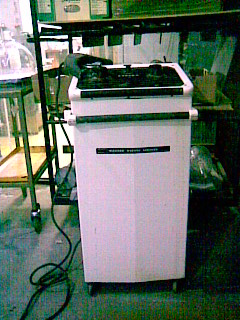 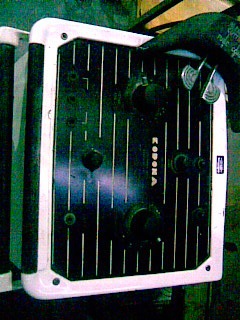 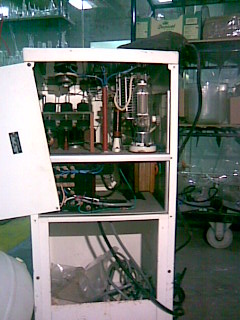 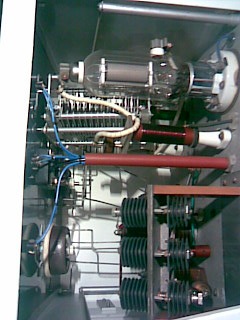 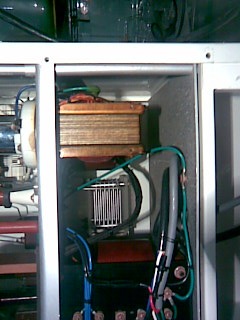
So two things intrigue me, those things in the fourth image that have like stacks of circle with spacers between them, there is a green one(x3) and a
silver one behind the valve.
Also a similar thing except this time a squarish box with what seems like aluminum wire wrapped precisely around it, but coarsely (ie not like a
motor)
Does anyone know if i can use this to make psuedoephedrine? That was joke<---Ha!
|
|
|
bquirky
Hazard to Others
  
Posts: 316
Registered: 22-10-2008
Location: Perth Western Australia
Member Is Offline
Mood: No Mood
|
|
Ok hear is a stab in the dark.. Is it a Xray powersupply ?
|
|
|
12AX7
Post Harlot
    
Posts: 4803
Registered: 8-3-2005
Location: oscillating
Member Is Offline
Mood: informative
|
|
Looks like it would make an excellent induction heater.
The green ones might be selenium rectifiers. The stacked plates are variable air capacitors. The coil is probably an inductor made with silver
plated copper tubing.
Tim
|
|
|
Waffles
Hazard to Others
  
Posts: 196
Registered: 1-10-2006
Member Is Offline
Mood: No Mood
|
|
by the way, you can get an extraordinarily cheap (and fun) nightvision IR viewer from thinkgeek.com or other places.
\"…\'tis man\'s perdition to be safe, when for the truth he ought to die.\"
|
|
|
chief
National Hazard
   
Posts: 630
Registered: 19-7-2007
Member Is Offline
Mood: No Mood
|
|
755 nm should be visible; we once used the beam of a spectrometer to test the range, and for each one it went to 800 nm, for me even to 804 ...
--> So the beam might or should be visible, although the intensity would be far greater than perceived ...
The damage to visibility can come from light in the mW-range, even 5 mW may do it in a split-second.
Focussing: As long as the light comes from a single resonator it is as if it came from a point-source, and therefore can be focussed; but the "beam
quality" ma be not too good ...
75 Joule: Thats something seriously capable; also a medical laser would be made for a lot of use ...
==> Perhaps you could try generating shockwaves at the surface of NH4NO3-crystals (coated with some graphite for the purpose ...)  ... maybe they can be set off ... ... maybe they can be set off ...
==> although the 50 ms are quite long, so peak-wattage is limited ... ... maybe it won't work
Then you still could drive the thing with another circuit ... and maybe other lamps/tubes ...
Just report anything interesting here !
What's the wattage or pulse-repetition rate ? Maybe it's at least good for reaching high temperatures ...
[Edited on 22-2-2010 by chief]
|
|
|
aonomus
Hazard to Others
  
Posts: 361
Registered: 18-10-2009
Location: Toronto, Canada
Member Is Offline
Mood: Refluxing
|
|
I can't help but notice the roundabout way of viewing the beam to focus it, or to safely deal with IR. Here is a good webstore for optics equipment
and supplies: http://thorlabs.com/
More specifically:
IR, UV, Vis viewing cards: http://thorlabs.com/NewGroupPage9.cfm?ObjectGroup_ID=296
Fluorescent alignment discs: http://thorlabs.com/NewGroupPage9.cfm?ObjectGroup_ID=3201
Laser safety: http://thorlabs.com/NewGroupPage9.cfm?ObjectGroup_ID=762
Hope it helps
|
|
|
Panache
International Hazard
    
Posts: 1290
Registered: 18-10-2007
Member Is Offline
Mood: Instead of being my deliverance, she had a resemblance to a Kat named Frankenstein
|
|
Quote: Originally posted by 12AX7  | Looks like it would make an excellent induction heater.
The green ones might be selenium rectifiers. The stacked plates are variable air capacitors. The coil is probably an inductor made with silver
plated copper tubing.
Tim |
On that note i took the outer off completely so i could get some better snaps, ok i really only removed it to have a look for capacitors which i
discovered (thnks to a thread here) may have Pd in them.
Well well well, i have some 150g so far of pd or pt foil, wooot what a find. As for the other bits any chance anyonbe can id them so i can keep or
toss.
Cheers
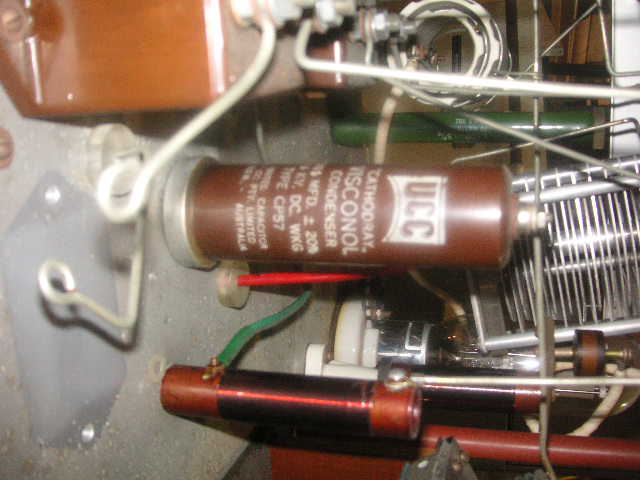 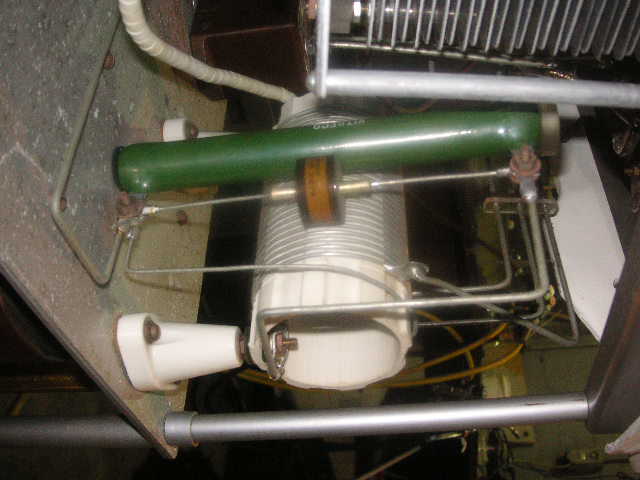 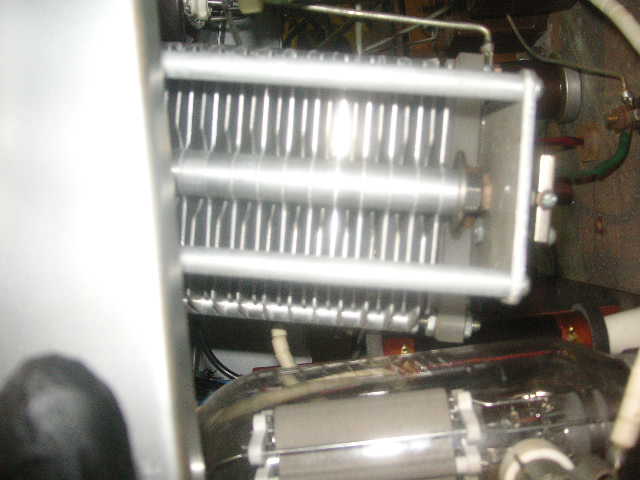 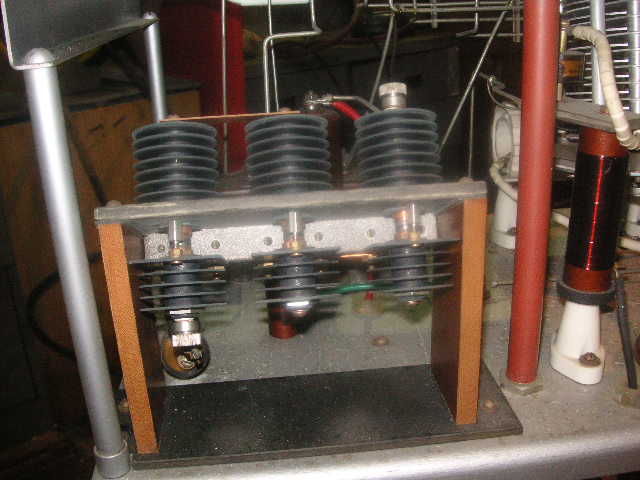 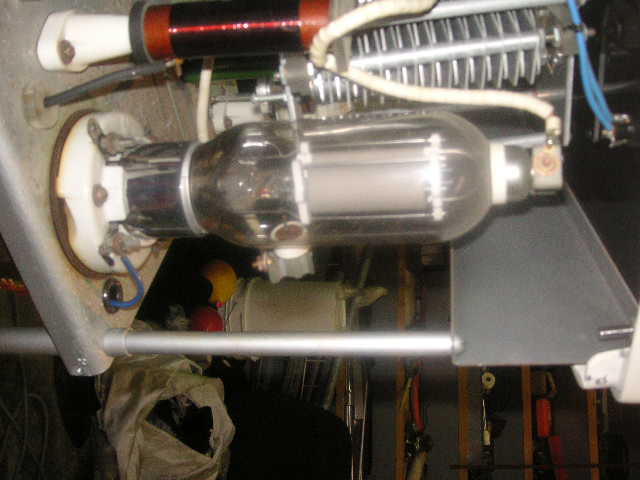 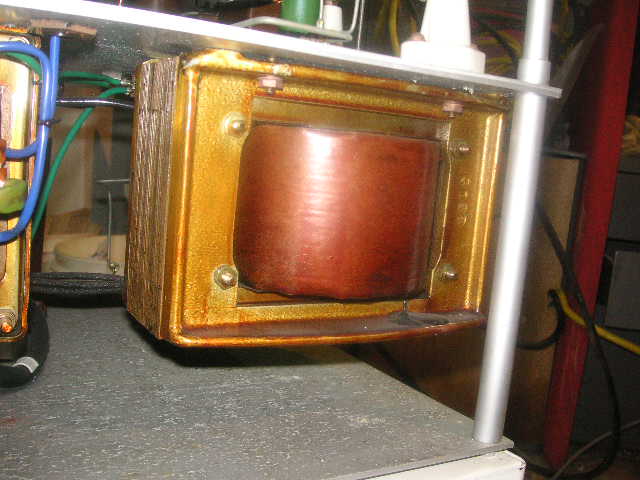 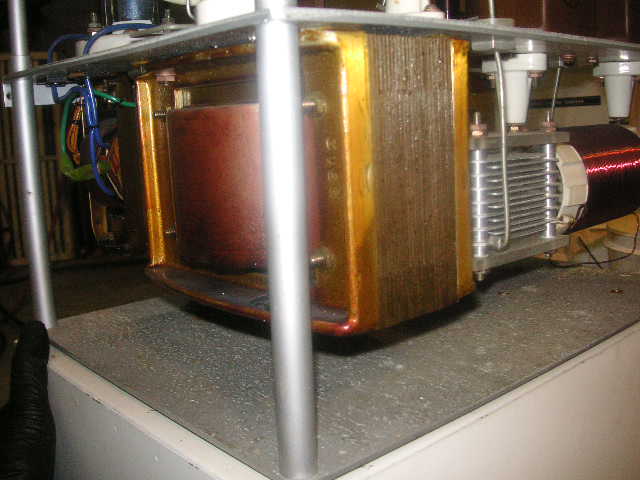
|
|
|
Ozone
International Hazard
    
Posts: 1269
Registered: 28-7-2005
Location: Good Olde USA
Member Is Offline
Mood: Integrated
|
|
"Watson/Fawkes hearmeroid cauteriser"
Funnnny!
Looks like a large RF power supply. Did you try to fire it up before cannibalizing it for loot?
O3
-Anyone who never made a mistake never tried anything new.
--Albert Einstein
|
|
|
Panache
International Hazard
    
Posts: 1290
Registered: 18-10-2007
Member Is Offline
Mood: Instead of being my deliverance, she had a resemblance to a Kat named Frankenstein
|
|
its actually only had one capacitors removed so far otherwise completely intact, that capacitor is one of bank of three identical ones with the loot
within them. I'm assuming that capacitor could be replaced now for $50. That was the assumption i made when forgiving myself for removing and
investigating it. i have little intention for it as it is quite elegant in its pragmatism.
|
|
|
densest
Hazard to Others
  
Posts: 359
Registered: 1-10-2005
Location: in the lehr
Member Is Offline
Mood: slowly warming to strain point
|
|
The disks-with-spacers in pict0009 are almost certainly selenium rectifiers. It points to a pre-silicon age 
Where did you hear that the capacitors could have Pd in them? It's possible that some small surface-mount capacitors have platinum group metals in the
metals on the ceramics, but in old stuff?
Guessing from the size of the air capacitors (maybe 300pF) and air coils (maybe 30microH), it's effectively a 1-10MHz radio transmitter designed to
give carefully controlled RF burns. Certain frequencies are/were reserved for diathermy and RF heating in that region of the spectrum.
The people building do-it-yourself cyclotrons would probably really like to use this item...
|
|
|
12AX7
Post Harlot
    
Posts: 4803
Registered: 8-3-2005
Location: oscillating
Member Is Offline
Mood: informative
|
|
Amazingly, I've heard of *solid* silver varicaps or inductors. Very rare I'm sure.
Almost all varicaps were aluminum, brass and steel construction, and almost all inductors were copper, or at best, silver plated.
Tim
|
|
|
Panache
International Hazard
    
Posts: 1290
Registered: 18-10-2007
Member Is Offline
Mood: Instead of being my deliverance, she had a resemblance to a Kat named Frankenstein
|
|
Quote: Originally posted by 12AX7  | Amazingly, I've heard of *solid* silver varicaps or inductors. Very rare I'm sure.
Almost all varicaps were aluminum, brass and steel construction, and almost all inductors were copper, or at best, silver plated.
Tim |
Hmm, i guess you guys already realize i know nothing about electronics. So much so i have no idea what the last three posts were about. Whats a
varicap? Ah wait thats a variable resistor. The ones with the pd/pt in them are not shown, they are mica capacitors. the mica/pd/pt stack is about
1inch by 2inches by 2inches i guess, the foil layers are ~0.0125mm the mica ones thicker. I'm assuming the pt/pd from how the foil behaves and from
what i've read. I'm hoping its not silver but as my metallurgy is about as competent as my electronics it may well be, do they make capacitors from
silver thin sheet.
Also the big valve thing has a fair thickness of material in it any idea of what is is, i'm assuming nickel.
Now if you think i'm struggling with this rather elegant but old fashioned device, imagine how many questions i will ask next week when my zeiss high
resolution EM 10c/cr electron microscope arrives.
Don't fret i have the instruction folder for this one, its says 'west germany' on it. In first few pages i'm reassured that it makes electron
microscopy 'easier than it ever has been'
So whats a recifier and is is made from solid selenium?
I honestly didn't know that rf could burn, i didn't really think about it, i assumed there was like a bit nichrome wire, lol. So what actually did the
surgeon use in his hand to shoot the rf?
|
|
|
12AX7
Post Harlot
    
Posts: 4803
Registered: 8-3-2005
Location: oscillating
Member Is Offline
Mood: informative
|
|
Ahh silver mica capacitors ("cap" is short for capacitors; the varicaps are the rotating vane things). Should've left them together, they're nicer as
capacitors than metal.
Does the vacuum tube have a part number on it? It's probably made of a combination of nickel, copper, iron, tunsten, graphite, ceramic, tantalum or
zirconium, among others. How much depends on what type. It looks like it may be worth something as-is.
A rectifier converts alternating line current to continuous DC, which is needed for the circuit (tubes only work in one direction). Selenium is a
semiconductor, used in thin layers between aluminum plates in the stack. They're supposed to smell terrible when they burn out; fortunately I've
never had this experience.
RF is an interesting animal. High frequencies don't much like to stay in wires. They tend to jump out at the earliest opportunity. The arc through
air is essentially continuous plasma, so it's wonderful for burning the hell out of anything you want. A metal scalpel, charged with RF, burns a hole
through anything organic and mildly conductive. RF burns are notorious among radio technicians, because a deep hole is burned out, which doesn't hurt
at first because of the nerve damage, but in time, the plug falls out and hurts like hell for weeks, as the deep damage heals. Or something like
that.
Tim
|
|
|
Panache
International Hazard
    
Posts: 1290
Registered: 18-10-2007
Member Is Offline
Mood: Instead of being my deliverance, she had a resemblance to a Kat named Frankenstein
|
|
damm silver, luckily i only opened one, might keep the unit intact now that i have your description.
|
|
|
| Pages:
1
2 |